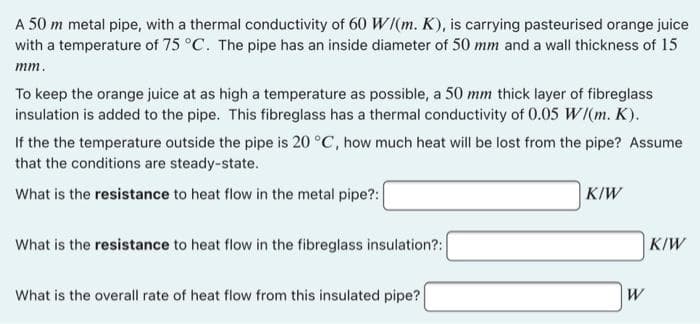A 50 m metal pipe, with a thermal conductivity of 60 W/(m. K), is carrying pasteurised orange juice with a temperature of 75 °C. The pipe has an inside diameter of 50 mm and a wall thickness of 15 mm. To keep the orange juice at as high a temperature as possible, a 50 mm thick layer of fibreglass insulation is added to the pipe. This fibreglass has a thermal conductivity of 0.05 W/(m. K). If the the temperature outside the pipe is 20 °C, how much heat will be lost from the pipe? Assume that the conditions are steady-state. What is the resistance to heat flow in the metal pipe?: What is the resistance to heat flow in the fibreglass insulation?: What is the overall rate of heat flow from this insulated pipe? K/W W K/W
A 50 m metal pipe, with a thermal conductivity of 60 W/(m. K), is carrying pasteurised orange juice with a temperature of 75 °C. The pipe has an inside diameter of 50 mm and a wall thickness of 15 mm. To keep the orange juice at as high a temperature as possible, a 50 mm thick layer of fibreglass insulation is added to the pipe. This fibreglass has a thermal conductivity of 0.05 W/(m. K). If the the temperature outside the pipe is 20 °C, how much heat will be lost from the pipe? Assume that the conditions are steady-state. What is the resistance to heat flow in the metal pipe?: What is the resistance to heat flow in the fibreglass insulation?: What is the overall rate of heat flow from this insulated pipe? K/W W K/W
Principles of Heat Transfer (Activate Learning with these NEW titles from Engineering!)
8th Edition
ISBN:9781305387102
Author:Kreith, Frank; Manglik, Raj M.
Publisher:Kreith, Frank; Manglik, Raj M.
Chapter7: Forced Convection Inside Tubes And Ducts
Section: Chapter Questions
Problem 7.50P
Related questions
Question
7

Transcribed Image Text:A 50 m metal pipe, with a thermal conductivity of 60 W/(m. K), is carrying pasteurised orange juice
with a temperature of 75 °C. The pipe has an inside diameter of 50 mm and a wall thickness of 15
mm.
To keep the orange juice at as high a temperature as possible, a 50 mm thick layer of fibreglass
insulation is added to the pipe. This fibreglass has a thermal conductivity of 0.05 W/(m. K).
If the the temperature outside the pipe is 20 °C, how much heat will be lost from the pipe? Assume
that the conditions are steady-state.
What is the resistance to heat flow in the metal pipe?:
What is the resistance to heat flow in the fibreglass insulation?:
What is the overall rate of heat flow from this insulated pipe?
KIW
W
K/W
Expert Solution
This question has been solved!
Explore an expertly crafted, step-by-step solution for a thorough understanding of key concepts.
Step by step
Solved in 2 steps with 2 images

Knowledge Booster
Learn more about
Need a deep-dive on the concept behind this application? Look no further. Learn more about this topic, mechanical-engineering and related others by exploring similar questions and additional content below.Recommended textbooks for you

Principles of Heat Transfer (Activate Learning wi…
Mechanical Engineering
ISBN:
9781305387102
Author:
Kreith, Frank; Manglik, Raj M.
Publisher:
Cengage Learning

Principles of Heat Transfer (Activate Learning wi…
Mechanical Engineering
ISBN:
9781305387102
Author:
Kreith, Frank; Manglik, Raj M.
Publisher:
Cengage Learning